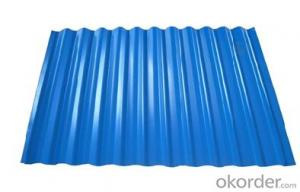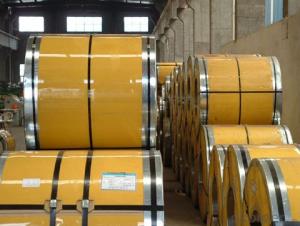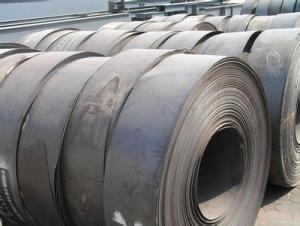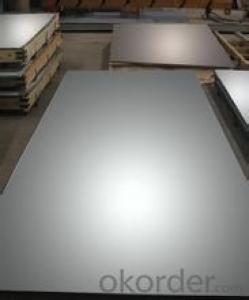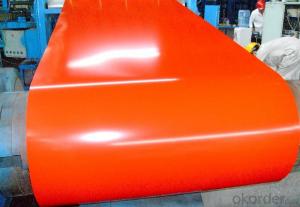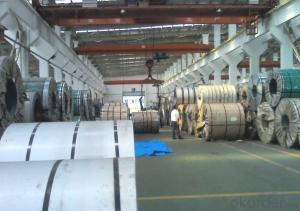Premium Colorful Corrugated GI Galvanized Metal Sheet
- Loading Port:
- Tianjin
- Payment Terms:
- TT OR LC
- Min Order Qty:
- 50 m.t.
- Supply Capability:
- 2000 m.t./month
OKorder Service Pledge
OKorder Financial Service
You Might Also Like
Item specifice
Product Brief Introduction
Premium Colorful Corrugated GI Galvanized Metal Sheet
Galvanized Corrugated Steel Roofing Sheet is formed by cold roll machine, using galvanized steel sheet or aluminum steel as the base material .Galvanized corrugated steel roofing sheet is featured with easy installation ,high strength ,more economic .( low cost )
Product Features
.Outlook Beautiful and novel, rich colors, flexible combination, can be used in different buildingto express special original architectural styles in life.
.Surface have been treated as galvanized and color coated.so it can anti-rain,anti- fire,anti-quake,So it has a long term life as 20-30 year and color just not fade.
. Light weight: easy to transport the material,short the time to finish the building,reduce worker's hard work,save much time and energy for human beings.
.Smooth surface treatment,the dust will be easy taken off by the rain.
. Environmental material,can be used many times,will do no hard to the our environment.
Product Specification
.Thickness:0.13mm to 0.8mm
.Length: 1m to 11.8m.
. Color: navy blue,white grey and any RAL colors.
. Certification: ISO9001:2000.
.Material : cold rolled galvanized steel coil.
. Standard: JIS,DX51D,SGCC,Q235. A653
. advantage: waterproof,light weight, high strength,best price.
. HS code: 7210700000
Packing Information (For 27.5 Tons heavy 20’Fcl)
. water proof paper packing in side
. plastic film Packing in middle
. steel sheet Packing out side
.several steel strip packing to fix the packing
Production Line & Package
FAQ
1. how many wave for per pcs
—— some wave is 8 ,same wave is 9 ,save wave is 11 ,it is up to your request
2. What is the MOQ for this products ?
—— Normally the MOQ is 25mt per size and per color .

- Q:What are the research and development efforts in steel strip technology?
- Various areas have been the focus of research and development efforts in steel strip technology, with the goal of improving the quality, performance, and efficiency of steel strip production. One particular area of research involves the development of advanced steel strip alloys that possess enhanced mechanical properties, such as increased strength and enhanced resistance to corrosion. This entails analyzing the microstructure and composition of different alloys and optimizing their processing parameters in order to achieve the desired properties. Improving manufacturing processes is another important aspect of research and development in steel strip technology. Innovations in processing techniques, such as continuous casting, hot rolling, and annealing, have been pursued in order to produce steel strip of high quality with minimal defects and dimensional consistency. The impact of process variables, such as temperature, rolling speed, and cooling rate, on the final product properties is also studied. Furthermore, efforts are being made to explore new coating and surface treatment technologies for steel strip. The objective of these endeavors is to enhance the surface properties of steel strip, including corrosion resistance, paint adhesion, and aesthetic appearance. Various coating techniques, such as electroplating, hot-dip galvanizing, and organic coatings, are being examined to identify the most effective and environmentally friendly solutions. Additionally, research in steel strip technology is also directed towards improving the energy efficiency and sustainability of steel strip production. This involves developing energy-saving processes, implementing recycling techniques for waste materials, and utilizing renewable energy sources in the manufacturing of steel strip. In summary, the research and development efforts in steel strip technology are focused on continuously enhancing the quality, performance, and sustainability of steel strip products to meet the evolving demands of industries such as automotive, construction, and packaging.
- Q:Can steel strips be used in the production of HVAC systems?
- Yes, steel strips can be used in the production of HVAC systems. Steel strips are commonly used in HVAC systems for various applications such as ductwork fabrication, heat exchangers, and support structures. Steel strips provide strength and durability, making them suitable for withstanding the rigorous demands of HVAC systems.
- Q:How are steel strips used in the production of aerospace components?
- Steel strips are used in the production of aerospace components for various purposes such as structural reinforcement, forming complex shapes, and providing strength and durability to the final product. These strips are often used to create brackets, fasteners, and other critical parts that require high strength-to-weight ratio and resistance to extreme conditions, ensuring the reliability and safety of aerospace components.
- Q:What is the tensile strength of a steel strip?
- When a steel strip is subjected to tension, its ability to resist breaking or becoming permanently deformed is referred to as its tensile strength. Factors such as the composition of the steel, its processing, and any additional treatments or coatings can affect the strength of the steel strip. Generally, steel strips have a high tensile strength, ranging from 400 to 2,000 megapascals (MPa), or 58,000 to 290,000 pounds per square inch (psi). However, the specific grade and type of steel being used can cause the exact tensile strength to vary. Therefore, it is important to either consult the manufacturer's specifications or carry out relevant tests in order to determine the precise tensile strength of a particular steel strip.
- Q:What are the different annealing processes for steel strips?
- There are several different annealing processes for steel strips, including full annealing, spheroidizing annealing, process annealing, and recrystallization annealing. Full annealing involves heating the steel strips to a temperature above the critical range and then slowly cooling them to room temperature. Spheroidizing annealing is used to improve machinability by heating the steel strips to a temperature below the critical range and then slowly cooling them. Process annealing is a low-temperature annealing process used to relieve internal stresses, improve ductility, and refine the grain structure. Recrystallization annealing is performed to eliminate cold work and restore the steel strips to their original soft state by heating them to a temperature below the critical range and then rapidly cooling them.
- Q:How are steel strips tested for corrosion resistance?
- Steel strips are typically tested for corrosion resistance through various methods such as salt spray testing, electrochemical testing, immersion testing, and humidity testing. These tests involve subjecting the steel strips to controlled environments or solutions that simulate corrosive conditions. The strips' resistance to corrosion is then evaluated by measuring factors like corrosion rate, appearance, and the formation of rust or oxide layers.
- Q:What are the recycling options for steel strips?
- Steel strips have various recycling options available. One common choice involves taking them to a scrap metal recycling facility. These facilities collect and sort steel strips, along with other metal items, before processing them for recycling. Typically, the steel strips are melted down, refined, and utilized to create new steel products. Another option is to repurpose steel strips for different applications. For instance, they can be employed in construction projects, serving as reinforcement in concrete structures or components in manufacturing processes. This approach helps decrease the demand for fresh steel and reduces waste. Additionally, individuals or organizations specializing in upcycling or creating artistic pieces from recycled materials may purchase or receive donated steel strips. This enables the transformation of the steel strips into unique and imaginative products, granting them a renewed purpose and existence. In summary, the recycling options for steel strips are varied and provide environmentally-friendly alternatives to simply disposing of them in landfills. By opting to recycle or repurpose steel strips, we can contribute to the conservation of natural resources, reduce energy consumption, and minimize the environmental impact of steel production.
- Q:What are the different methods of joining steel strips together?
- There are several methods of joining steel strips together, each with its own advantages and applications. Some of the common methods include welding, bolting, riveting, and adhesive bonding. Welding is the most widely used method for joining steel strips. It involves melting and fusing the edges of the strips together using heat and pressure. Welding provides a strong and permanent bond, making it ideal for structural applications. Different welding techniques such as arc welding, gas welding, and laser welding can be used depending on the thickness and type of steel. Bolting is another method where steel strips are joined together using bolts, nuts, and washers. This method offers the advantage of easy disassembly and reassembly, making it suitable for applications that require frequent maintenance or adjustments. Bolting is commonly used in the construction industry for connecting steel beams and plates. Riveting involves driving a rivet through the overlapping steel strips and then deforming the end to create a permanent joint. This method is mainly used for connecting thin-gauge steel strips and provides a reliable and visually appealing joint. Riveting is commonly employed in the automotive and aerospace industries. Adhesive bonding is a method where a specialized adhesive is applied between the steel strips to create a strong bond. This method is particularly useful when joining dissimilar metals or when welding is not feasible due to material constraints. Adhesive bonding also offers the advantage of distributing stress evenly across the joint, reducing the risk of fatigue failure. Each method of joining steel strips has its own strengths and limitations, and the choice depends on factors such as the specific application, material properties, required strength, and environmental conditions. It is important to carefully evaluate these factors before selecting the most suitable joining method for a particular project.
- Q:Can steel strips be customized according to specific requirements?
- Yes, steel strips can be customized according to specific requirements.
- Q:Can steel strips be used for making electrical contacts?
- Steel strips are capable of being used to create electrical contacts. Steel, being a versatile material, possesses outstanding electrical conductivity and mechanical strength, rendering it appropriate for a multitude of applications, including electrical contacts. By manipulating steel strips, they can be transformed into an array of shapes, such as springs, clips, or connectors, thereby facilitating electrical connections between diverse components or devices. Additionally, applying coatings of metals such as nickel or silver onto steel strips serves to amplify their conductivity and safeguard against corrosion. In summary, steel strips present a dependable and economically viable alternative for fabricating electrical contacts in a wide range of industries, encompassing electronics, automotive, and telecommunications.
1. Manufacturer Overview |
|
|---|---|
| Location | |
| Year Established | |
| Annual Output Value | |
| Main Markets | |
| Company Certifications | |
2. Manufacturer Certificates |
|
|---|---|
| a) Certification Name | |
| Range | |
| Reference | |
| Validity Period | |
3. Manufacturer Capability |
|
|---|---|
| a)Trade Capacity | |
| Nearest Port | |
| Export Percentage | |
| No.of Employees in Trade Department | |
| Language Spoken: | |
| b)Factory Information | |
| Factory Size: | |
| No. of Production Lines | |
| Contract Manufacturing | |
| Product Price Range | |
Send your message to us
Premium Colorful Corrugated GI Galvanized Metal Sheet
- Loading Port:
- Tianjin
- Payment Terms:
- TT OR LC
- Min Order Qty:
- 50 m.t.
- Supply Capability:
- 2000 m.t./month
OKorder Service Pledge
OKorder Financial Service
Similar products
New products
Hot products
Related keywords
